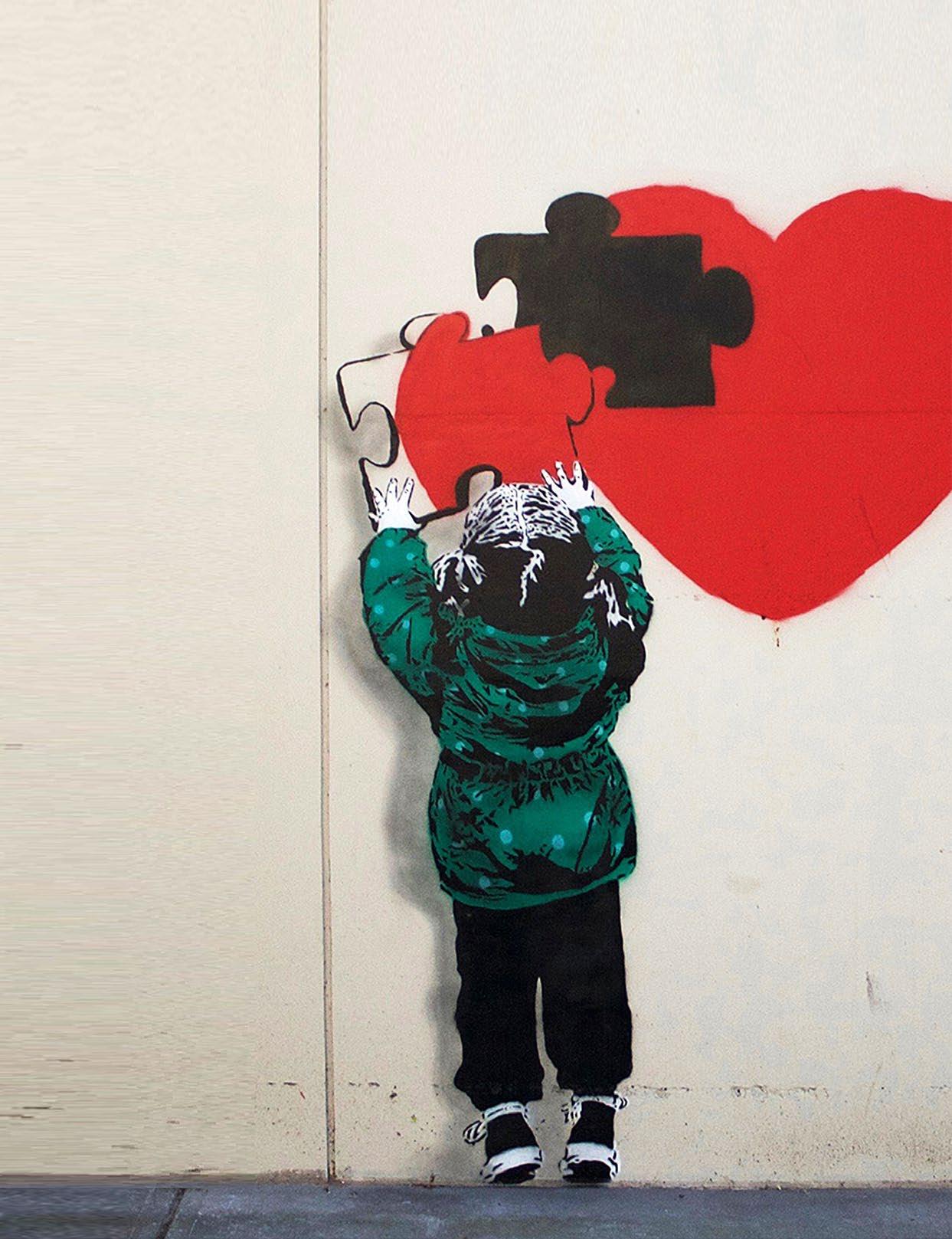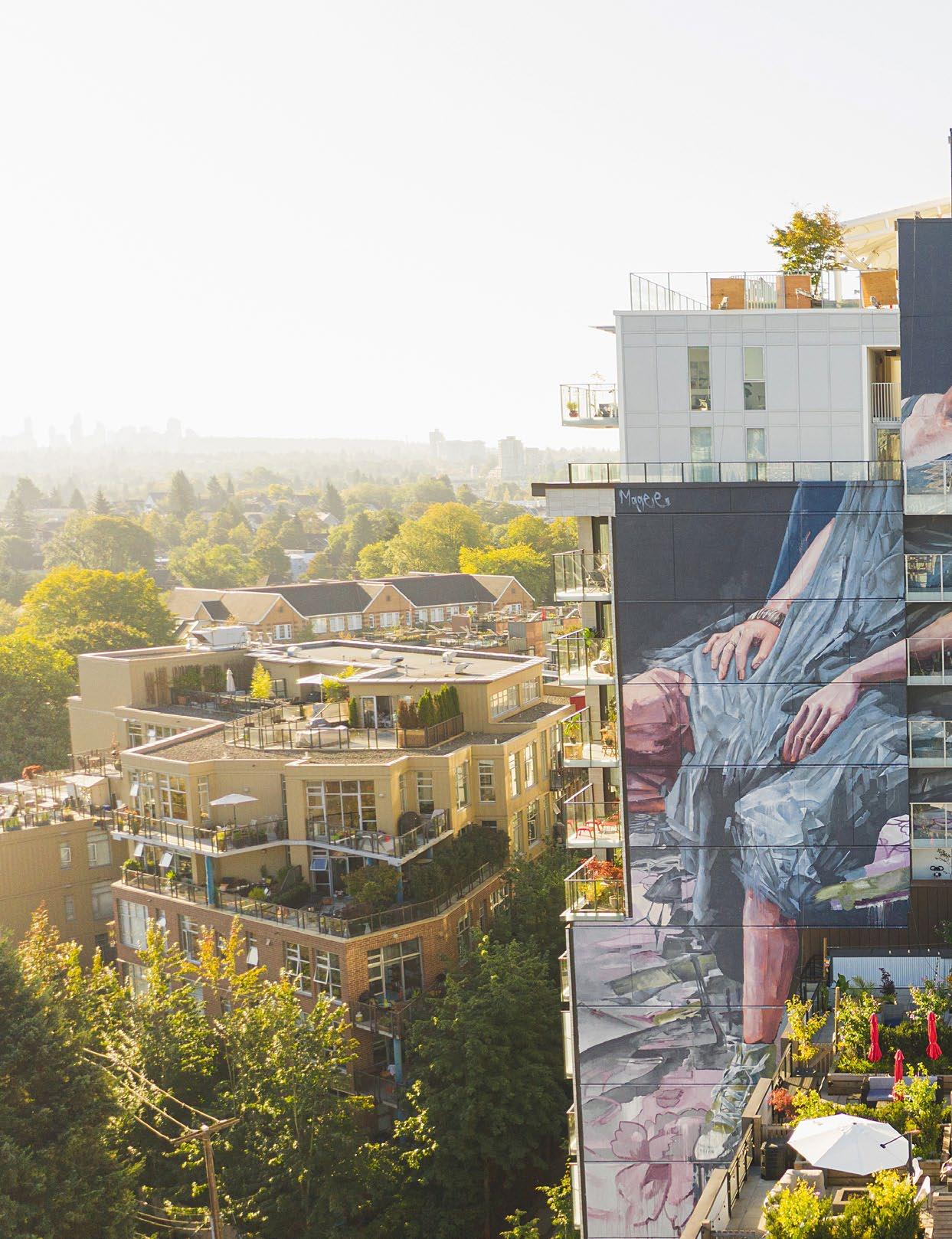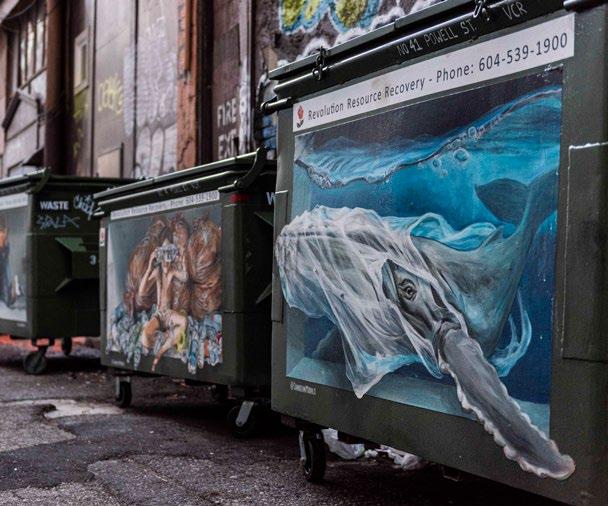THE POWER OF THE PAINT BRUSH





I n the earliest days of the pandemic, Vancouver’s downtown core almost immediately transformed from vibrant business district to deserted streetscape. Shops and restaurants were boarded over with walls of plywood, and the world took refuge at home.
“It was almost apocalyptic,” recalls Andrea Curtis, executive director and co-founder of the Vancouver Mural Festival. “And I knew this was our job. That plywood needed to be painted now.”

By Stephanie Cunningham




Since its inception five years ago, the Vancouver Mural Festival (VMF) has created more than 250 murals around town. Its flagship annual event is typically held during the summer months, but as the city descended into pandemic restrictions, Curtis and her colleagues quickly shifted their focus to more immediate needs.
“Like so many other organizations, everything was suddenly up in the air about what we were going to be able to do that summer,” Curtis recalls. “In the midst of trying to work this out with our leadership team, I caught a newsletter from urbanYVR with photos of all the boarded-up buildings and it was enormous. I couldn’t believe that’s what our downtown looked like and I forwarded it to my colleagues and said, ‘This is it. Let’s go.’”
VMF organizers contacted the Downtown, South Granville and Robson business improvement associations and with the financial support of Vancity to help compensate artists for their work and contributions of paint made by the City of Vancouver, the wheels were soon set in motion. The plain plywood walls were quickly transformed into massive works of colourful art and a sense of optimistic determination took hold.
“It was one of those rare moments when I really didn’t feel I had to explain to anybody why art is powerful,” Curtis says.
As a member of the band Hey Ocean!, VMF cofounder David Vertesi noticed that no matter what city he and the band visited on tour, they could always locate the local arts district because that’s where you would find the murals.
“Every major city has a mural district,” notes Curtis. “And even though Vancouver has the highest number of working artists per capita of any city in Canada, we don’t wear it on the outside.”
Upon his return to home soil, Vertesi met with business owners, city staff, artists, non-profits and
anyone else who would listen to his idea of a mural festival. His ultimate goal was not just to host a fun event, but to change the way Vancouver saw both art and itself.
His idea sparked the formation of a grassroots organization and in 2016 VMF painted its first 40 murals. “It was a tremendous amount of work that first year,” Curtis recalls, “and the moment it happened we knew we were on to something.”
Now much more than just a summer street party, the organization has evolved during its short life and produces two annual festivals, consults yearround on large-scale art, and produces a range of pop-up events.
At the heart of each and every VMF project is the desire to create public art that is accessible, inclusive and reflects the diversity of the city in which it resides. It’s about community building.
“After the first year of murals went up, we didn’t really know what kind of impact it would have,” says Curtis.
It didn’t take long before organizers, residents and businesses alike began to see a change. Not only did the murals transform public spaces, they made alleys feel safer to walk in, businesses more attractive, and walkways more welcoming for tourists.
“But what became really apparent to us was the power of visibility for different traditionally marginalized groups in the work that we’re doing,” says Curtis.
The depth of that impact was soon driven home when Musqueam artist and weaver Debra Sparrow called the VMF offices after seeing some photos of the festival murals on the cover of The Georgia Straight.
“She said, ‘Good job on Indigenous murals, but where’s the Musqueam?’” recalls Curtis. “We thought, good point. Let’s talk about this.”
Since that day in 2017, VMF has worked with Sparrow on her Blanketing the City mural concept. One of the first projects in the series was blanketing







“ What became really apparent to us was the power of visibility for different traditionally marginalized groups.
Andrea Curtis, co-founder, Vancouver Mural Festival
two pillars under the Granville Street bridge with Musqueam designs.
“A lot of the designs that people think of as west coast art are usually Haida and northern coast art,” notes Curtis. “So, working with Debra has been a really exciting opportunity to not just showcase what is Coast Salish from this territory, but to show designs that have traditionally been created by women through their blanket weaving.”
VMF’s latest endeavour is the Black Strathcona Resurgence Project, for which the organization recently won a BC Heritage Award in the Education, Communications & Awareness category.
Painted by artist Anthony Joseph, the lively mural on the north face of the Georgia Viaduct is titled “Hope Through Ashes: A Requiem for Hogan’s Alley” – a reference to the area that was demolished more than 50 years ago to make way for the construction of the viaduct.
“In painting a mural about Hogan’s Alley on the Georgia Viaduct, I am adding art to the very instrument that led to the destruction of Vancouver’s first concentrated Black community,” says Joseph of his work.
In an effort to utilize public art as a means to reclaim and educate the public on Vancouver’s Black history, VMF has embarked on this three-year project with the goal of completing five to eight murals per year.
“The murals do feel like a bit of a Trojan Horse for us, being able to cloak really important and really intense social issues in celebration, in art, in creativity, and that’s our vehicle to drive the conversation forward in a positive way,” says Curtis.

After seeing the positive response to its #MakeArtWhileApart initiative during the early days of the pandemic, VMF was keen to find other ways to help the city build back better and support the local tourism industry in a way that was both safe and distanced.
As every Vancouverite knows, February is a dark and damp month and can be a bit of a let-down after the hype of the holidays and with little else going on in the city. Thus, the idea of a VMF Winter Arts Festival was born as a counterbalance to the gloom.
Converging 2D with technology, 14 large pillars covered in 25 works of art were installed in various locations around the downtown core and in the Mount Pleasant area. Standing in front of these, viewers could scan a QR code with their phone and an augmented reality artwork would pop up on screen.
To make it all happen, VMF worked with Indigenous virtual reality artists from the IM4 Lab at Emily Carr, other local artists and creators from around the world.
The public’s response was unexpected: “It was the middle of a pandemic in February, and we had over 30,000 scans of those QR codes,” says Curtis.
The proverbial “mural goggles”
VMF may still be a young organization, but its track record is impressive.
To date, VMF has directed more than $2 million to artists, their projects and their training. Ninety-two per cent of its artists are local, 47 per cent are women and non-binary, and 45 (20 per cent) are Indigenous.
Its business model has also evolved. In the early days, VMF was supported by the City of Vancouver through its innovation fund. “When the innovation fund had run its course, we were really fortunate to access support at the federal and provincial levels,” says Curtis.
“More than anything, bringing on board a lot of local businesses – from the local café that gave us a wall to some of the biggest developers in the province –that’s helped support our work. We now have a business model that operates with grants, but we also work with project partners.”
We often think of murals as just for walls but take a look at some of VMF’s past works and you’ll soon notice that it includes artwork on concrete road barriers and even dumpster bins.
“When you start working with the Vancouver Mural Festival you’re handed a set of proverbial ‘mural goggles,’” says Curtis, “and it really doesn’t take long

for our new staff to walk around the city and see any enormous flat surface as a potential mural wall.
“We spy walls that we want, and we go after them. We knock on doors, we ask for permission, we seek funding and then some businesses just come to us.”
As for artists, every year the festival takes in anywhere between 600 to 800 artist applications from around the world. First and foremost, curators choose emerging and local talent, but the festival also likes to book some of the international “big guns” as well.
“There’s kind of a crew of travelling rock stars that go from city to city around the world painting enormous buildings,” Curtis says. “Watching them paint is other-worldly: they are so adept and so fast at scaling these buildings and they put art on them in an impossibly short amount of time. It’s incredible to watch.”

With so many projects on the go, VMF is busy yearround, but the festival’s roots are still planted in its summer street event, which in pre-pandemic 2019 drew some 150,000 spectators. And although this year’s festival to be held August 4 to 22nd will look different yet again, Curtis is confident they have a plan that works.
“Art is a very solitary thing and last year during our pandemic pivot our artists were able to work safely alone. Any of our crew who were helping were able to suit up in PPE and along with additional safety requirements we could make sure that support to the artists was distanced and safe,” she says.
The sheer size of the artworks spread across 11 neighbourhoods also works in VMF’s favour. Some of the largest murals are several stories tall, allowing audience members to stand well back and still catch a view of the artist at work.
As in 2020, festival organizers are planning to host an outdoor pop-up patio with more than 40 live performances, if provincial health regulations permit. But, to find out the most up-to-date information about what’s going on and where, the VMF app is an essential must-have. It’s chock full of maps showing the locations of each mural, details about the artists and insights into their works.
“Vancouver has not slept during this pandemic,” concludes Curtis. “We have continued to create and produce and to dream up new things that Vancouver never thought possible before. That’s a big part of who we are and what we’re doing – surprising Vancouverites and helping Vancouverites to surprise themselves.”